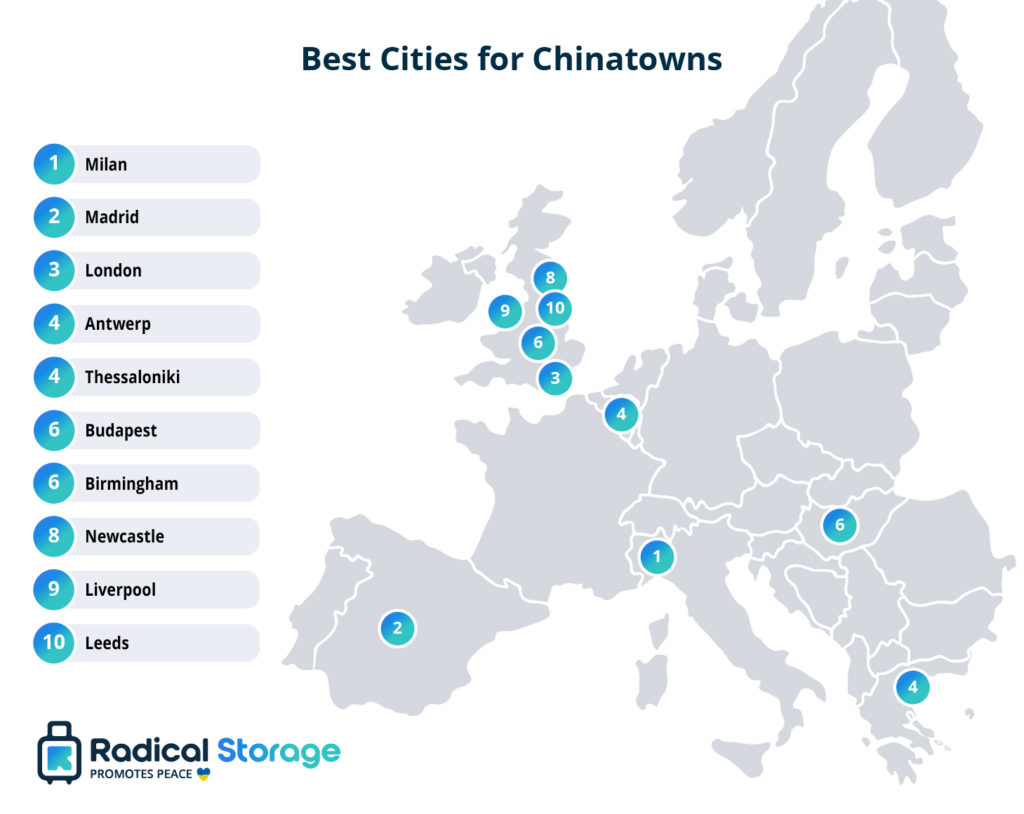
The Best Chinatowns in Europe
Did you know that the oldest Chinatown in the world is in Binodo, Manila, established in 1594? Chinatowns across the world provide rich culture, authentic Chinese cuisine, and stunning architecture to the hearts of cities across the globe. Chinatowns are referred to as ‘ethnic enclaves’, a place where Chinese migrants flock to outside of China. The Best Chinatowns in Europe
For tourists, this means having an authentic taste of China when they might actually be thousands of miles away from Beijing. This sparked the question: in which Chinatowns are tourists getting the best experience?
Radical Storage took the biggest Chinatowns in Europe and reviewed the number of restaurants, the average ratings of these restaurants and cafés, and the total number of events happening in these cities’ Chinatowns.
Europe’s best Chinatowns
Milan, Italy—close to Porta Garibaldi and not so far from the iconic Duomo—has the best Chinatown in Europe with an overall index score of 6.2 out of 10, with the second most restaurants in a Chinatown (47) and is the second cheapest for food in our analysis, with the average price of a starter and a main at £10.7.
Madrid, Spain, has the second-best Chinatown in the world, with the highest overall score of 5.8 out of 10. Alongside London, this metropolitan Spanish city has the most Chinese New Year events being held in any Chinatown in our analysis, with three different events celebrating the New Year happening across each city.
In third place is London, UK, with an overall score of 5.5. London, the capital of the UK, has the most restaurants and cafés in any Chinatown in Europe, with 65 across the famous Chinatown. London did, however, have the lowest average rating for its Chinatown eateries, rating an average of 3.8 out of 5, the lowest of any city in the analysis.

Rank | City | Country | No of eateries per 100,000 | Average rating (Google Maps) | Average food price (starter + main) | Final Index (/10) |
1 | Milan | Italy | 1.5 | 4.1 | £10.71 | 6.2 |
2 | Madrid | Spain | 0.2 | 3.9 | £17.38 | 5.8 |
3 | London | United Kingdom | 0.7 | 3.8 | £24.13 | 5.5 |
4 | Antwerp | Belgium | 2.0 | 4.0 | £15.46 | 5.3 |
4 | Thessaloniki | Greece | 2.2 | 4.3 | £11.56 | 5.3 |
6 | Budapest | Hungary | 1.0 | 4.4 | £8.95 | 5.1 |
6 | Birmingham | United Kingdom | 1.8 | 4.1 | £14.87 | 5.1 |
8 | Newcastle | United Kingdom | 6.2 | 4.3 | £14.87 | 5.0 |
9 | Liverpool | United Kingdom | 2.1 | 4.2 | £13.80 | 4.8 |
10 | Leeds | United Kingdom | 3.7 | 4.1 | £13.60 | 4.6 |
Where are the best European Chinatowns for food?
Vila de Conde, Portugal, has the most restaurants and cafes per person, with 6.3 per 100,000 per capita. It also has the highest average ratings from restaurants in Chinatown, with an average rating score of 4.8 on Google Maps. Restaurants include Restaurante Chines Macau and Restaurante Asiatico, rated a respectable 4.4 and 4.2 on Google.
Budapest, Hungary, has the cheapest average meals in Chinatown, with the average price of a starter and a main at £8.95, a huge £16.15 cheaper than a meal in London’s Chinatown. then have one last bite to eat in Chinatown before departing from Keleti or Nyugati stations. Restaurants here include the Spicy Fish Restaurant and Panda Wok in Budapest’s Chinatown, which have ratings of 4.4 and 4.3 on Google.
This index reviewed a range of factors to create an overall ranking score. It is worth noting that these are overall averages and do not factor in the scale of events happening across the cities or immigration numbers, as this was not publicly available.
Methodology
Radical Storage took data from a seed list of Chinatowns across Europe and used Google to find the number of restaurants and cafés in each of these Chinatowns. They took the ratings of each of these restaurants from Google Maps along with the price and the number of reviews, calculating the averages for each of them. Looking at the top 3 recommended Chinese restaurants on Google Maps, they analyzed their menus in each Chinatown to get average price data, specifically comparing the price of a standardized starter and a main.
Radical Storage used population data from WorldPopulation to calculate how many restaurants and cafés were present per 100,000 per capita in each Chinatown.
All data was scored using a normalized ten-point index per data point, and then an average score was created using all categories’ ten-point score, which gives us the best to worst Chinatown.
The best airline tickets & hotels are just a click away.







